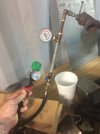I have been helping a member with his forge build. I thought I would post some of the info on building the burner.
He had asked about my reference to a "chamber" in the burner.
It is a good idea to have a "bulge" in the burner as a mixing chamber. This is where the gas and air mix to more fully burn in the chamber. It adds a lot to the forge efficiency. You just use a larger piece of pipe and two "bell reducer" adapters. If the burner is 1" pipe, then a 3" piece of 3" pipe is the mixing chamber. Thus, you use two 1" to 3" bell reducer adapters to make the burner go from 1" to 3" to 1" again, and then out into the forge chamber. The bell reducers are standard fittings at plumping supply and hardware stores. Here is a link to what I am talking about. Use the sizes available in your area. The chamber can be any size at least twice the burner pipe size. 2.5 or 3" works great.
http://catalog.industrialpipega.com/viewitems/black-malleable-sch-40-80-fittings/bell-reducers-2
The burner pipe size for a medium size forge could be 1" or 1.25". That mostly depends on what use it will see. If doing regular forging and HT, 1" is plenty. If welding damascus, 1.25 would be great (but the 1" will still do fine). 1" is what I would suggest, unless you plan on making a larger forge in the future, or doing lots of welding. ( The whole burner can be moved from forge to forge for many years of use.) The length of the pipe pieces used to make the burner isn't terribly important as long as it has about an 8" long pipe as the burner tube going to the forge.
If I was to make up a shopping list for building a top notch 1" burner for a 5-6" chamber by 14-16" long forge it would be (starting from the blower):
Blower - 100-150CFM range, preferably variable speed. A fan/light controller will often work as a speed control. DC blowers are super if you find one.
2" floor flange. You need some sort of flange or other fitting so the blower can connect to the burner piping.
**
2" closed nipple to connect flange to next item.
2" gate valve. A gate valve is placed here to adjust the blast from the blower. If using a speed control, the valve may not be needed, but a ball valve is still a good idea.
****
4" piece 2" pipe.
2" by 1" bell reducer
1" closed nipple.
1" street elbow ( ell)
****
1" tee with a 1"X1/4" reducer bushing in the side port. This is where the gas valve is placed. A 1/4" needle valve is used to control the gas flow. The gas line connects here. Using "quick connect" gas fittings on the gas hose is a really good idea. HTT&R has them, as well as most everything else needed to make a great burner.
3" piece of 1" pipe
1" by 3" bell reducer
3" piece of 3" pipe
1" by 3" bell reducer
8" piece of 1" stainless steel pipe. This is the burner tube to enter the forge. Stainless pipe is recommended here, everything else can be black iron. Buy a spare of this pipe, as it will need replacing eventually.
****If everything was kept linear, the whole burner would be a good 36" long. That will work fine, but takes up a lot of room and is a balance issue. Placing an "ell" in the setup right before the "tee" not only shortens the length of the assembly, but places the blower in a hanging down position below the forge which keeps hot gases from flowing up into the blower when the forge is shut off. A good practice is to always shut off the gate/ball valve when shutting down the forge.
Make a bracket or brace of some sort to support the burner arm and blower, as just hanging it from the forge is pretty unstable. If building the forge on a rolling cart, weld this brace to the cart.
 PC140070 by JK2900, on Flickr
PC140070 by JK2900, on Flickr PC140070 by JK2900, on Flickr
PC140070 by JK2900, on Flickr


